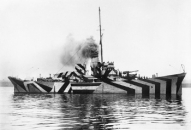Dazzleship on Liverpool Waterfront
Date uploaded: March 31, 2014
Liverpool Biennial and Tate Liverpool will jointly commission Carlos Cruz-Diez to work with the idea of ‘dazzle’ camouflage in partnership with National Museums Liverpool using an historic pilot ship conserved by Merseyside Maritime Museum. The “Edmund Gardner” is situated in a dry dock adjacent to Liverpool’s Albert Dock and this will be a new public monument for the city.
The ship will be seen during the International Festival for Business and will be accompanied by a display exploring the history of Dazzle Ships and the role of artists in the First World War.
Carlos Cruz-Diez is one of the great figures of contemporary art, especially kinetic-optic art. His works can be found in the permanent collections of Museum of Modern Art, New York; Tate Modern, London; Centre Georges Pompidou, Paris; Museum of Fine Arts, Houston; Wallraf-Richartz Museum, Cologne.
In London the HMS President, which was formerly a Dazzle Ship during the First World War, will also be ‘dazzled’ by a contemporary artist in a co-commission by Chelsea College of Art and Design.
Dazzle painting was a system for camouflaging ships that was introduced in early 1917, at a time when German submarines were threatening to cut off Britain’s trade and supplies. The idea was not to “hide” the ships, but to paint them in such a way that their appearance was optically distorted, so that it was difficult for a submarine to calculate the course the ship was travelling on, and so know from what angle to attack. The “dazzle” was achieved by painting the ship in contrasting stripes and curves that broke up its shape. Characterised by garish colours and a sharp patchwork design of interlocking shapes, the spectacular ‘dazzle’ style was heavily indebted to Cubism.
Dazzle painting was invented by a marine painter, Norman Wilkinson, a future President of the Royal Institute of Painters in Watercolours. Artist Edward Wadsworth, who supervised the application of ‘dazzle’ patterning to over 2,000 ships, later made a series of paintings on the subject.
The close relationship of ‘dazzle’ technology to British art extended right through its manufacture. Each British pattern was unique, and many of the designs were invented by women from the Royal Academy of Arts in London. These were then tested on wooden models, viewed through a periscope in a studio to assess how they would work at sea. Though the practice has largely (but not entirely) fallen out of fashion in the military, ‘dazzle’ remains a source of inspiration to artists today.
Details of the commissioned artists and ship locations will be announced in April 2014. For more information, please click here.
Co-commissioned by 14-18 NOW, Liverpool Biennial, Tate Liverpool and Chelsea College of Art and Design.

